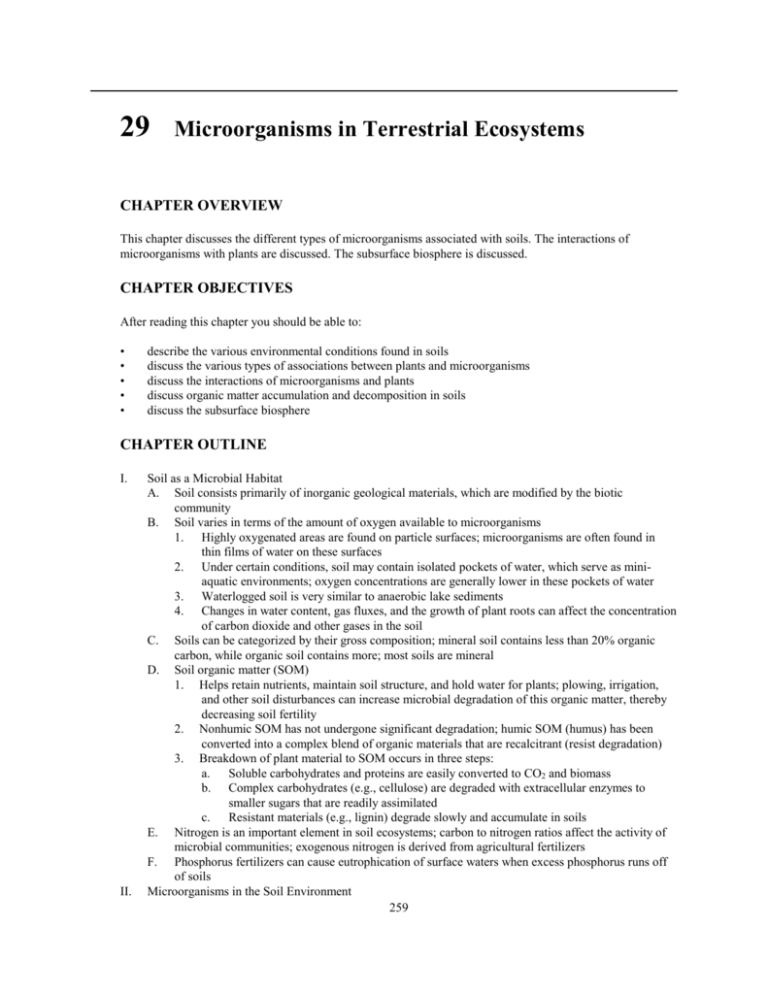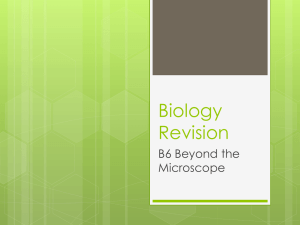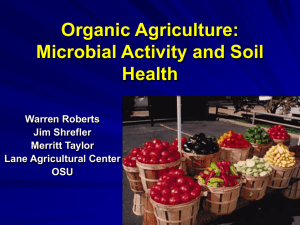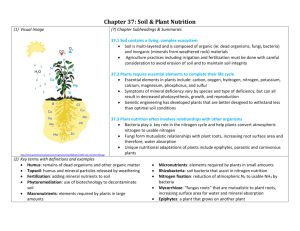chapter objectives
advertisement

29 Microorganisms in Terrestrial Ecosystems CHAPTER OVERVIEW This chapter discusses the different types of microorganisms associated with soils. The interactions of microorganisms with plants are discussed. The subsurface biosphere is discussed. CHAPTER OBJECTIVES After reading this chapter you should be able to: • • • • • describe the various environmental conditions found in soils discuss the various types of associations between plants and microorganisms discuss the interactions of microorganisms and plants discuss organic matter accumulation and decomposition in soils discuss the subsurface biosphere CHAPTER OUTLINE I. II. Soil as a Microbial Habitat A. Soil consists primarily of inorganic geological materials, which are modified by the biotic community B. Soil varies in terms of the amount of oxygen available to microorganisms 1. Highly oxygenated areas are found on particle surfaces; microorganisms are often found in thin films of water on these surfaces 2. Under certain conditions, soil may contain isolated pockets of water, which serve as miniaquatic environments; oxygen concentrations are generally lower in these pockets of water 3. Waterlogged soil is very similar to anaerobic lake sediments 4. Changes in water content, gas fluxes, and the growth of plant roots can affect the concentration of carbon dioxide and other gases in the soil C. Soils can be categorized by their gross composition; mineral soil contains less than 20% organic carbon, while organic soil contains more; most soils are mineral D. Soil organic matter (SOM) 1. Helps retain nutrients, maintain soil structure, and hold water for plants; plowing, irrigation, and other soil disturbances can increase microbial degradation of this organic matter, thereby decreasing soil fertility 2. Nonhumic SOM has not undergone significant degradation; humic SOM (humus) has been converted into a complex blend of organic materials that are recalcitrant (resist degradation) 3. Breakdown of plant material to SOM occurs in three steps: a. Soluble carbohydrates and proteins are easily converted to CO2 and biomass b. Complex carbohydrates (e.g., cellulose) are degraded with extracellular enzymes to smaller sugars that are readily assimilated c. Resistant materials (e.g., lignin) degrade slowly and accumulate in soils E. Nitrogen is an important element in soil ecosystems; carbon to nitrogen ratios affect the activity of microbial communities; exogenous nitrogen is derived from agricultural fertilizers F. Phosphorus fertilizers can cause eutrophication of surface waters when excess phosphorus runs off of soils Microorganisms in the Soil Environment 259 A. Bacteria in soils are remarkably diverse and numerous with thousands of species in each gram of soil; the vast majority of rRNA genes are from novel genera that lie within nine phyla; fungal and archaeal diversity may rival that of bacteria B. Bacteria are found primarily on the surfaces of soil particles, most frequently on surfaces of pores in these particles; this probably protects them from predation by protozoa and gives them access to soluble nutrients C. Filamentous fungi form bridges between separated particles or aggregates called peds; this exposes the fungi to high levels of oxygen; filamentous fungi move nutrients and water over great distances in the soil D. The microbial loop in soils differs from that of the open ocean; in soils plants (not microbes) are primary producers; microbes still rapidly turn over organic matter, making the nutrients available to higher trophic levels (predatory protozoa); degradative enzymes released from animals, plants, insects, and microbes contribute to soil biochemistry III. Microorganism Associations with Vascular Plants A. Many types of plant-microbe interactions exist; commensalism is a relationship wherein one partner is benefited, while mutualism benefits both partners; epiphytes live on plant surfaces; endophytes colonize internal tissues; plant exudates support bacterial growth and competing saprotrophic and pathogenic fungi B. Phyllosphere microorganisms—a wide variety of microorganisms (Sphingomonas, Pseudomonas, Erwinia) are found on and in the aerial surfaces of plants (phyllosphere), where they can utilize organic compounds released by the leaves and stems C. Rhizosphere and rhizoplane microorganisms a. The rhizosphere is the volume of soil around plant roots influenced by materials released by the plants; the rhizoplane is the root surface; both provide unique environments for microorganisms; microorganisms in the rhizosphere serve as a labile source of nutrients and play a critical role in organic matter synthesis and degradation b. Numerous rhizosphere bacteria influence plant growth through the release of auxins, gibberellins, cytokinins, and other molecules c. Associative nitrogen fixation—nitrogen fixation carried out by bacteria on the rhizoplanes and in the rhizosphere D. Mycorrhizae 1. Mutualistic fungus-root associations in which the fungi are not saprophytic, but use photosynthetically derived host carbohydrates 2. Six associations have been described; they fall into two broad categories: a. Ectomycorrhizae 1) Ascomycete or basidiomycete fungi that grow as an external sheath around the root and may grow between (but not within) cortical root cells, forming the Hartig net 2) Fungal hyphae can aggregate in soils, forming rhizomorphs that bring nutrients to the plant b. Endomycorrhizae 1) Fungi that penetrate the outer cortical cells of the plant root 2) Arbuscular mycorrhizae form characteristic structures known as arbuscules within invaginations in the plasma membrane of cortical root cells; they protect from disease and drought, and bring nutrients to the plant 3) Orchid endomycorrhizae are saprophytic and bring nutrients to the plant 3. Mycelia extend far into the soil, forming a mycorrhizosphere, and mediate nutrient transfer to the plant; mycorrhizae increase the competitiveness of the plant and increase water uptake by the plant in arid environments; they also make it possible to share resources (e.g., carbon, minerals, and water); mycorrhizal helper bacteria aid in the development of the mycorrhizal relationships E. Nitrogen-fixing bacteria 1. Symbiotic nitrogen fixation (conversion of nitrogen gas to ammonia) by bacteria associated with plants is crucial for global nitrogen cycles and agriculture; often performed by Rhizobium in root nodules on legumes 260 2. The Rhizobia a. Rhizobium—a prominent member of the rhizosphere community; it can also establish an endosymbiotic association with legumes and fix nitrogen for use by the plant b. The initial reaction of the plant is an oxidative burst; the Rhizobium survives this because of its antioxidant abilities and it is subsequently stimulated (by plant flavonoid inducer molecules) to produce Nod factors, which activate the host responses necessary for root hair infection and nodule development c. The bacterium induces formation of an infection thread by the plant; the infection thread grows down into the root hair d. Rhizobium spreads within the infection thread into the underlying root cells, eventually giving rise to the nodule e. Bacteria terminally differentiate into bacteroids that are enclosed by a plant-derived membrane called the peribacteroid membrane f. Further growth and differentiation lead to the formation of nitrogen-fixing forms called symbiosomes g. Nitrogen fixation occurs within symbiosomes within the root nodules which are protected from oxygen by leghemoglobin; the nitrogen is then assimilated into various organic compounds and distributed throughout the plant 3. Stem-nodulating rhizobia—bacteria that form nodules at the base of adventitious roots branching out of the stem above the soil surface; observed primarily in tropical legumes; the nodulation process differs from that of the rhizobia 4. Actinorrhizae—actinomycete-root associations between members of the genus Frankia and woody plants; Frankia can fix nitrogen and are important in the life of woody, shrublike plants; the nodules take the form of lateral root clusters F. Agrobacterium 1. Members of this genus that contain the Ti (tumor-inducing) plasmid cause the formation of crown galls (tumors) on the plant 2. Gall formation is a complex process that involves transfer of Ti DNA into the plant host and expression of a set of vir (virulence) genes 3. The Ti plasmid is an important biotechnology tool for transfer of new genetic characteristics into plants G. Other plant pathogens—Fungi, protists, and bacteria as plant pathogens—many fungi and bacteria are plant pathogens, causing rusts, blights, rots, and other plant diseases; many viruses infect plants and cause disease and economic losses (e.g., tobacco mosaic virus) IV. The Subsurface Biosphere A. Studied by examining outcrops, surface excavations, petroleum hydrocarbons, well corings, and materials from deep mine sites B. The subsurface biosphere may contain about one-third of the Earth's living biomass C. Microbial processes take place in different regions 1. Shallow subsurface aquifers where water flowing from the surface moves below the plant root zone 2. Subsurface regions where organic matter has been transformed by chemical and biological processes to yield coal, kerogens, and oil and gas; mobile materials move up into more porous geological structures where microorganisms can be active 3. Deeper biogenic zones where methane is being synthesized using geologic hydrogen as an energy source TERMS AND DEFINITIONS Place the letter of each term in the space next to the definition or description that best matches it. ____ 1. An initial response by plants to root nodule-forming bacteria; it involves the production of a mixture that 261 ____ 2. ____ 3. ____ 4. ____ 5. ____ 6. ____ 7. ____ 8. ____ 9. ____ 10. ____ 11. ____ 12. ____ 13. can contain superoxide radicals, hydrogen peroxide, and N2O Porous geological structures below the plant root zone, through which water often flows The volume of soil around a plant root that is influenced by materials released from the root Tumorigenic plasmid carried by Agrobacterium strains Bacteria and fungi that infect and live within plants Heterogeneous soil aggregates formed partly by bacterial and fungal growth in soil Substances that activate the host symbiotic processes necessary for infection of root hairs by Rhizobium Rhizobial cells found in root nodules; when fully differentiated they are capable of nitrogen fixation Nutrients available in a soluble form Organisms found growing on the surface of a plant Fungi that form symbiotic relationships with plant roots bringing nutrients to the plant The above-ground portions of a plant that acts as a home for a microbial community Bacteria that form symbiotic relationships with plant roots, forming nodules, and fixing nitrogen a. b. c. d. e. f. g. h. i. j. k. l. m. aquifers bacteroids dissolved organic matter endophytes epiphyte mycorrhizae Nod factors oxidative burst peds phyllosphere rhizobia rhizosphere Ti plasmid FILL IN THE BLANK 1. 2. 3. 4. 5. Plants can develop relationships with two or three different types of microorganisms. Several examples are known. One involves a host plant, , and rhizobia. Another involves a host plant, endomycorrhizae, and (association with actinomycetes). A third association involves a host plant, , and actinorrhizae. Certain bacterial genera (e.g., Azotobacter and Azospirillum) carry out nitrogen fixation on the surface of plant roots (i.e., the ). This type of nitrogen fixation is called ____________ nitrogen fixation. Associations between fungi and plant roots are referred to as mycorrhizae: if this association involves the growth of the fungi as a sheath around the root tip with limited penetration of the hyphae into the cortical region of the root, it is called ; however, if extensive penetration of the fungal hyphae into the cortical regions of the plant root occurs, then it is called . Certain of the latter type of mycorrhizae have a characteristic structure called the ____________, and fungi with this structure are called fungi. Certain tropical legumes are infected by , which form nodules at the base of adventitious roots branching out of the stem just above the soil surface. Members of the genus Rhizobium infect the root hairs of legumes, stimulating the plant to form an ____________ ____________ down which the bacteria travel. Eventually the bacteria are released into a host cell and are surrounded by a plant membrane to become . After further differentiation they become nitrogen-fixing and are located in swollen structures called . MULTIPLE CHOICE For each of the questions below select the one best answer. 1. Which of the following is NOT used by soil microorganisms to support their growth? a. b. 262 moisture contained in soil pores dissolved nutrients associated with soil particles or in pores c. 2. 3. 4. organic matter released from the plant roots d. All of the above are used to support growth of soil microorganisms. Which of the following is NOT a benefit to the plant involved in a mycorrhizal association? a. increased nutrient availability in moist environments b. increased water availability in arid environments c. increased utilization of photosynthate d. All of the above are benefits to the plant of mycorrhizal associations. Mycorrhizal helper bacteria (MHBs) help with which of the following? a. ectomycorrhizal development b. endomycorrhizal development c. Both (a) and (b) are correct. d. Neither (a) nor (b) is correct. Which of the following types of compounds are released by microorganisms and influence plant growth? a. auxins b. gibberellins c. cytokinins d. all of the above 5. 6. 7. 8. Which term refers to the aerial surfaces of plants? a. mycorrhizosphere b. phyllosphere c. residuesphere d. subsurface biosphere Bacterial symbionts have been identified in the cytoplasm of arbuscular mycorrhizal fungi. What is the role of these bacteria thought to be? a. They act as an energy source for the fungus. b. They synthesize amino acids needed by the plant and fungus. c. They inhibit the growth of the fungus and disrupt the mycorrhizae. d. none of the above Which microorganisms play a predominant role in the decomposition of lignin-containing materials of woody plants? a. bacteria b. archaea c. fungi d. viruses In which of the following mycorrhizal associations does the fungus invade plant cells? a. orchid endomycorrhizae b. ericoid endomycorrhizae c. arbuscular mycorrhizae d. all of the above TRUE/FALSE ____ 1. ____ 2. Soils that are very wet tend to be anaerobic. Endomycorrhizae are detrimental to desert plants because they limit water uptake by the plant, which is growing in an already arid environment. ____ 3. Agrobacterium, a tumor-producing bacterium that infects plants, has been of recent interest because of its possible use as a vector for genetically engineering plants. ____ 4. The vast majority of microorganisms found in soils have been cultivated in the laboratory. ____ 5. Soil consists of both organic and inorganic materials. ____ 6. Microorganisms inhabit five major subsurface zones. ____ 7. In an ideal soil, microorganisms function in thin water films that have close contact with air. ____ 8. Most microbes in soil are embedded in the anoxic zones of soil particles. ____ 9. Soil organic matter tends to remain the same regardless of environmental conditions. ____ 10. Decomposition seems to be maximal at a carbon-to-nitrogen ratio of 30. ____ 11. Although the phyllosphere is a stable environment, it is nearly devoid of microbial life. ____ 12. Arbuscular fungi develop within folds in the plasma membrane of host plant cells. 263 CRITICAL THINKING 1. Draw a cross section of a soil aggregate (ped), showing the location of bacteria, fungi, and protozoa, and showing the relative availability of oxygen throughout the aggregate. 2. Describe the process of nodulation by rhizobia. What factors are important for host responses? What is the nature of the symbiosis? How might this relationship have occurred evolutionarily? ANSWER KEY Terms and Definitions 1. h, 2. a, 3. l, 4. m, 5. d, 6. i, 7. g, 8. b, 9. i, 10. e, 11. f, 12. j, 13. k Fill in the Blank 1. endomycorrhizae; actinorrhizae; ectomycorrhizae 2. rhizoplane; associative 3. ectomycorrhizae; endomycorrhizae; arbuscule; arbuscular mycorrhizal 4. stem-nodulating rhizobia 5. infection thread; bacteroids; symbiosomes; root nodules Multiple Choice 1. d, 2. c, 3. a, 4. d, 5. b, 6. b, 7. c, 8. d True/False 1. T, 2. F, 3. T, 4. F, 5. T, 6. F, 7. T, 8. F, 9. F, 10. T, 11. F, 12. T 264







